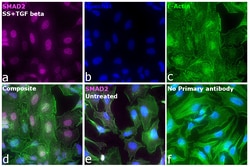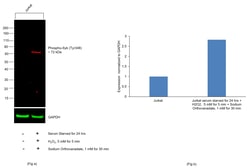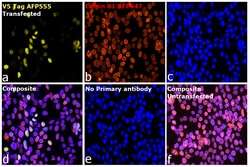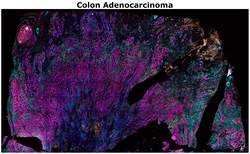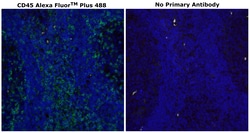
All Primary Antibodies
Primary antibodies, immunoglobulins that bind to specific proteins or other biomolecules, are used in many research applications and protocols to detect targets of interest. They are developed using different animal hosts, including mouse, rat, rabbit, goat, sheep, and many others.
Monoclonal and Polyclonal Antibodies
One type of primary antibodies, monoclonal antibodies, provides high reproducibility and low cross-reactivity and background noise. Another type, polyclonal antibodies, often costs less and provides greater affinity and quicker binding. Both are produced using plasma B cells, but the former uses the same clone and the latter uses different clones. Monoclonal antibodies require hybridoma cell lines, and polyclonal antibodies do not.
There are also recombinant monoclonal antibodies with similar benefits, like high affinity, scalability, and specificity. They are produced using in vitro cloning of plasma B cells and expression hosts.
Conjugated Primary Antibodies
Antibodies can be labeled with various fluorophores or detection agents or used without labels. Labeled primary antibodies, also known as conjugated primary antibodies, help researchers simplify and streamline their applications. They are coupled with common enzymes and dyes such as Alexa Fluor and often used in protein and cell analysis.
Applications
Antibodies for life sciences applications are used in flow cytometry, western blotting, ELISA, immunohistochemistry, and immunocytochemistry. Secondary antibodies can be added to support the detection and purification of certain antigens. They bind to the primary antibody, which binds to the antigen of interest. Finding the right combination of antibodies can result in greater antigen specificity and a strong, detectable signal.
- (2)
- (4)
- (1)
- (2)
- (1)
- (3)
- (2)
- (56)
- (23)
- (660)
- (1,747)
- (1)
- (1,025)
- (38)
- (1)
- (225)
- (1)
- (1)
- (59)
- (73,806)
- (30,055)
- (34)
- (4,375)
- (6)
- (3)
- (6)
- (13)
- (2)
- (1)
- (114)
- (4)
- (2)
- (1)
- (1)
- (2)
- (112)
- (170)
- (5)
- (5,775)
- (82)
- (1)
- (2,752)
- (2,154)
- (9)
- (2)
- (147)
- (2,997)
- (2,083)
- (26)
- (1)
- (40)
- (257)
- (1)
- (1)
- (3)
- (2)
- (1)
- (29)
- (1)
- (3,099)
- (3)
- (1)
- (5)
- (1)
- (2)
- (12)
- (2)
- (2,315)
- (3)
- (2)
- (1)
- (1)
- (7)
- (83)
- (3,515)
- (4,840)
- (30)
- (17)
- (1,172)
- (1)
- (1,670)
- (1)
- (2)
- (19)
- (1)
- (37)
- (1)
- (1)
- (2)
- (3)
- (1)
- (1)
- (1,516)
- (8)
- (4)
- (41)
- (225)
- (10)
- (6)
- (5)
- (473)
- (12)
- (62)
- (43)
- (48)
- (8)
- (168)
- (1)
- (3)
- (72)
- (208)
- (62)
- (64)
- (27)
- (75)
- (18)
- (8)
- (1)
- (1)
- (1)
- (1)
- (2,110)
- (10)
- (125)
- (70)
- (90)
- (110)
- (110)
- (164)
- (143)
- (154)
- (122)
- (90)
- (122)
- (122)
- (99)
- (1)
- (16)
- (1)
- (75)
- (52)
- (1)
- (57)
- (2)
- (1)
- (8)
- (5)
- (1,973)
- (34)
- (551)
- (300)
- (2)
- (1)
- (103)
- (11)
- (20)
- (58)
- (28)
- (130)
- (171)
- (25)
- (88)
- (52)
- (44)
- (70)
- (10)
- (75)
- (81)
- (97)
- (86)
- (86)
- (58)
- (56)
- (34)
- (48)
- (51)
- (51)
- (107)
- (130)
- (41)
- (64)
- (65)
- (84)
- (68)
- (2,073)
- (7)
- (4)
- (1)
- (146)
- (66)
- (591)
- (2)
- (19)
- (171)
- (32)
- (24)
- (286)
- (149)
- (495)
- (12)
- (13)
- (5)
- (6)
- (2)
- (2)
- (7)
- (5)
- (1)
- (168)
- (141)
- (50)
- (72)
- (63)
- (12)
- (5)
- (8)
- (3)
- (10)
- (2)
- (62)
- (1)
- (128,240)
- (19)
- (2)
- (362)
- (66)
- (46)
- (22)
- (269)
- (68)
- (42,272)
- (2)
- (85,743)
- (17,294)
- (21)
- (283)
- (56)
- (898)
- (1)
- (8)
- (260)
- (1)
- (2)
- (1)
- (4)
- (4,074)
- (61)
- (7)
- (3,015)
- (40)
- (8)
- (37,519)
- (7)
- (8)
- (92,672)
- (6,300)
- (607)
- (128)
- (40)
- (23)
- (2)
- (4)
- (12)
- (1)
- (1,590)
- (136)
- (3)
- (57)
- (2)
- (27)
- (2)
- (552)
- (3)
- (29,037)
- (21)
- (14)
- (31,341)
- (1)
- (1)
- (3)
- (3,488)
- (1)
- (110)
- (8)
- (1)
- (35)
- (15)
- (45,970)
- (15)
- (15)
- (2,854)
- (7,946)
- (2)
- (60)
- (3,012)
- (984)
- (54,682)
- (110)
- (12,615)
- (2)
- (49)
- (40)
- (101)
- (27)
- (574)
- (45)
- (101)
- (243)
- (68)
- (38)
- (6)
- (124)
- (148)
- (776)
- (2)
- (66)
- (4)
- (2)
- (1)
- (47)
- (1)
- (65)
- (339)
- (607)
- (2)
- (1,810)
- (39)
- (16)
- (3)
- (1)
- (103,539)
- (4)
Filtered Search Results
CHD4 Recombinant Human Monoclonal Antibody (K49015_15E2), Invitrogen™
Human Recombinant Monoclonal Antibody
| Content And Storage | Store at 4°C short term. For long term storage, store at -20°C, avoiding freeze/thaw cycles. |
|---|---|
| Target Species | Human |
| Host Species | Human |
| Conjugate | Unconjugated |
| Applications | ELISA,Western Blot |
| Form | Liquid |
| Isotype | IgG1 |
| Gene Accession No. | Q14839 |
| Concentration | 1 mg/mL |
| Antigen | CHD4 |
| Regulatory Status | RUO |
| Purification Method | Protein A |
| Gene Alias | 9530019N15Rik; AA617397; ATP-dependent helicase CHD4; BC005710; Chd4; CHD-4; chromodomain helicase DNA binding protein 4; chromodomain-helicase-DNA-binding protein 4; D6Ertd380e; Mi-2; Mi-2 autoantigen; Mi-2 autoantigen 218 kDa protein; Mi-2 beta; MI2B; Mi-2b; Mi-2beta; Mi2-BETA; mKIAA4075 |
| Gene | CHD4 |
| Product Type | Antibody |
| Gene ID (Entrez) | 1108 |
| Formulation | PBS with 0.09% sodium azide |
| Immunogen | Recombinant human CHD4 (immunogen range is 1291-1550). |
| Classification | Recombinant Monoclonal |
| Primary or Secondary | Primary |
| Clone | K49015_15E2 |
CD20 Monoclonal Antibody (2H7), Brilliant Ultra Violet™ 395, eBioscience™, Invitrogen™
 Greener Choice
Greener Choice
Offers one or more environmental benefits itemized in the U.S. FTC “Green Guides.”
Learn More

Offers one or more environmental benefits itemized in the U.S. FTC “Green Guides.”
Learn More
Mouse Monoclonal Antibody
| Content And Storage | 4°C, store in dark, DO NOT FREEZE! |
|---|---|
| Target Species | Human |
| Host Species | Mouse |
| Conjugate | Brilliant Ultraviolet 395 |
| Applications | Flow Cytometry |
| Form | Liquid |
| Isotype | IgG2b κ |
| Gene Accession No. | P11836 |
| Concentration | 5 μL/Test |
| Antigen | CD20 |
| Regulatory Status | RUO |
| Purification Method | Affinity chromatography |
| Gene Alias | AA960661; APY; ATOPY; B1; B-cell differentiation antigen Ly-44; B-lymphocyte antigen CD20; B-lymphocyte cell-surface antigen B1; B-lymphocyte surface antigen B1; Bp35; Cd20; CD20 antigen; CD20 cell surface protein; CD20 receptor; CVID5; EGK_06167; Fc epsilon receptor I beta chain; Fc Fragment of IgE high affinity I receptor for beta polypeptide; FCER1B; High affinity immunoglobulin epsilon receptor subunit beta; IgE Fc receptor subunit beta; IGEL; IGER; IGHER; LEU16; LEU-16; Leukocyte surface antigen Leu-16; Ly44; Ly-44; Lymphocyte antigen 44; membrane spanning 4-domains A1; membrane-spanning 4-domains subfamily A member 1; membrane-spanning 4-domains, subfamily A, member 1; membrane-spanning 4-domains, subfamily A, member 2; MGC3969; MS4A1; MS4A2; S7 |
| Gene | Ms4a1 |
| Product Type | Antibody |
| Gene ID (Entrez) | 931 |
| Formulation | PBS with BSA and 0.09% sodium azide; pH 7.2 |
| Classification | Monoclonal |
| Primary or Secondary | Primary |
| Clone | 2H7 |
Epredia™ Lab Vision™ CD71/Transferrin Receptor Ab-3, Mouse Monoclonal Antibody
Ensure accurate, reproducible results in immunohistochemistry applications with Epredia™ CD71/Transferrin Receptor Ab-3, Mouse Monoclonal Antibody.
| Antigen | CD71/Transferrin Receptor Ab-3 |
|---|---|
| Regulatory Status | RUO |
| Target Species | Human |
| Host Species | Mouse |
| Conjugate | Unconjugated |
| Applications | Immunohistochemistry (Paraffin) |
| Classification | Monoclonal |
| Isotype | IgG2b |
| Primary or Secondary | Primary |
| Clone | 10F11 |
MHC II (HLA-DR) Ab-1 Mouse Monoclonal Antibody, Epredia™
Epredia™ MHC II (HLA-DR) Ab-1, Mouse Monoclonal Antibody provides accurate, reproducible results.
| Antigen | MHC II (HLA-DR) Ab-1 |
|---|---|
| Regulatory Status | RUO |
| Target Species | Human |
| Host Species | Mouse |
| Conjugate | Unconjugated |
| Applications | Flow Cytometry,Immunohistochemistry (Paraffin) |
| Form | Concentrated |
| Immunogen | Activated human peripheral blood mononuclear cells |
| Classification | Monoclonal |
| Isotype | IgG2b |
| Primary or Secondary | Primary |
| Research Discipline | Hematopoietic |
| Clone | LN3 |
Progesterone Receptor Ab-6 Mouse Monoclonal Antibody, Epredia™
Provide accurate, reproducible results with the Epredia™ Progesterone Receptor Ab-6, Mouse Monoclonal Antibody.
| Antigen | Progesterone Receptor Ab-6 |
|---|---|
| Regulatory Status | RUO |
| Target Species | Bovine,Chicken,Human,Rabbit |
| Host Species | Mouse |
| Conjugate | Unconjugated |
| Applications | Immunofluorescence,Immunoprecipitation |
| Form | Concentrated |
| Immunogen | Partially purified PgR from a human endometrial carcinoma (EnCa 101) grown in athymic mice |
| Classification | Monoclonal |
| Isotype | IgG2b |
| Primary or Secondary | Primary |
| Research Discipline | Cancer and Tumor Biology |
| Clone | hPRa 6 |
Invitrogen™ H3K27me2 Polyclonal Antibody
 Greener Choice
Greener Choice
Offers one or more environmental benefits itemized in the U.S. FTC “Green Guides.”
Learn More

Offers one or more environmental benefits itemized in the U.S. FTC “Green Guides.”
Learn More
Rabbit Polyclonal Antibody
| Content And Storage | Store at 4°C short term. For long term storage, store at -20°C, avoiding freeze/thaw cycles. |
|---|---|
| Target Species | Human |
| Host Species | Rabbit |
| Conjugate | Unconjugated |
| Applications | Immunocytochemistry,Western Blot |
| Form | Liquid |
| Gene Accession No. | P68431, Q71DI3 |
| Isotype | IgG |
| Concentration | 0.5 mg/mL |
| Antigen | H3K27me2 |
| Gene Symbols | H3C1, H3C10, H3C12, H3C14, H3C15, H3C2, H3C7 |
| Regulatory Status | RUO |
| Purification Method | Affinity Chromatography |
| Gene Alias | dimethyl H3; di-methyl H3; Dimethyl Histone H3; di-methyl histone H3; Di-Methyl-H3 K27; Di-Methyl-H3 Lys27; Di-Methyl-Histone H3 K27; Di-Methyl-Histone H3 Lys27; Di-Tri-Methyl-Histone H3 K27; Di-Tri-Methyl-Histone H3 Lys27; H3; H3 histone; H3 histone family, member A; H3 histone family, member I; H3 histone family, member K; H3 histone family, member L; H3 histone family, member M; H3 histone, family 2; H3 histone, family 3A; H3 histone, family 3B; H3 histone, family 3B (H3.3B); H3 histone, family 3B.1; H3 histone, family 3C; H3 K27me2; H3.1-221; H3.1-291; H3.1-I; H3.2; H3.2-221; H3.2-614; H3.2-615; H3.2-616; H3.3A; H3.3B; H3.5; H3/A; H3/b; H3/d; H3/f; H3/i; H3/j; H3/k; H3/l; H3/M; H3/n; H3/o; H3-143; H3-291; H3-3A; H3-3B; h3-5; H3-53; H3-614; H3a; H3b; H3-B; H3C1; H3c10; H3c11; H3C12; H3C2; H3C3; H3C4; H3C6; H3C7; H3C8; H3f; H3-F; H3F1K; H3F2; H3F3; h3f3a; H3F3B; h3f3b.1; h3f3c; h3f3d; H3FA; H3FB; H3FC HIST1H3C; H3FD; H3FF; H3FH; H3FI; H3FJ; H3FK; H3FL; H3FM; H3FN; H3g; H3h; H3i; H3k27; H3K27me2/3; H3K27me2me3; H3Lys27me2; H3Lys27me2/3; H3Lys27me2me3; Hist1; HIST1H3A; HIST1H3B; Hist1h3c; HIST1H3D; Hist1h3e; HIST1H3F; Hist1h3g; HIST1H3H; HIST1H3I; HIST1H3J; HIST2H3A; Hist2h3b; HIST2H3C; Hist2h3c1; Hist2h3c2; Hist2h3c2-ps; Hist2h3ca1; Hist2h3ca2; HIST2H3D; histone 1, H3a; histone 1, H3b; histone 1, H3f; histone 1, H3h; histone 2, H3a; histone 2, H3c; histone 2, H3c2; histone 2, H3ca2; Histone 3; histone cluster 1, H3a; histone cluster 1, H3b; histone cluster 1, H3f; histone cluster 1, H3h; histone cluster 2, H3a; histone cluster 2, H3c; histone cluster 2, H3c2; histone cluster 2, H3c2, pseudogene; histone gene complex 1; histone H3; histone H3.1; Histone H3.2; histone H3.3; Histone H3.3C; histone H3.5; Histone H3/a; Histone H3/b; Histone H3/c; Histone H3/d; Histone H3/f; Histone H3/h; Histone H3/i; Histone H3/j; Histone H3/k; histone H3/l; Histone H3/m; histone H3/o; Histone H3K27; Histone H3K27me2; histone variant H3.5; hypothetical protein LOC550262; M32461; methyl Histone 3; methyl Histone H3; PP781; wu:fa25h06; wu:fa96g06; wu:fb07a08; wu:fb36f01; zgc:110292; zgc:174300; zgc:56193; zgc:56418; zgc:64222; zgc:86731 |
| Gene | H3C15 |
| Product Type | Antibody |
| Gene ID (Entrez) | 126961, 333932, 8350, 8356, 8357, 8358, 8968 |
| Formulation | PBS with 0.1% BSA, 30% glycerol and 0.09% sodium azide; pH 7.2 |
| Immunogen | Peptide corresponding to Human HIST1H3A (aa 24-31). |
| Classification | Polyclonal |
| Primary or Secondary | Primary |
CIRBP Mouse anti-Human, Clone:6E12B3, Abnova™
Mouse monoclonal antibody raised against recombinant human CIRBP.
Invitrogen™ SMAD2 Recombinant Rabbit Monoclonal Antibody (31H15L4), Alexa Fluor™ Plus 488
Rabbit Recombinant Monoclonal Antibody
| Content And Storage | 4°C, store in dark, DO NOT FREEZE! |
|---|---|
| Target Species | Human |
| Host Species | Rabbit |
| Conjugate | Alexa Fluor Plus 488 |
| Applications | Western Blot,Immunocytochemistry |
| Form | Liquid |
| Gene Accession No. | Q15796 |
| Isotype | IgG |
| Concentration | 1 mg/mL |
| Antigen | SMAD2 |
| Gene Symbols | SMAD2 |
| Regulatory Status | RUO |
| Purification Method | Protein A/G |
| Gene Alias | 7120426M23Rik; EGK_09664; hMAD-2; hSMAD2; JV18; JV18-1; MAD; MAD homolog 2; Mad protein homolog; Madh2; Madr2; Mad-related protein 2; MGC22139; MGC34440; mMad2; mother against DPP homolog 2; mothers against decapentaplegic homolog 2; Mothers against decapentaplegic-like protein 2; mothers against DPP homolog 2; pSMAD2; Sma- and Mad-related protein 2; SMAD; SMAD 2; SMAD family member 2; SMAD, mothers against DPP homolog 2; Smad2; Smad-2; Smad2Deltaexon3 |
| Gene | SMAD2 |
| Product Type | Antibody |
| Gene ID (Entrez) | 4087 |
| Formulation | Proprietary buffer with 0.008% Bromonitrodioxane, 0.008% Methylisothiazolone; pH 6.3-7.3 |
| Classification | Recombinant Monoclonal |
| Primary or Secondary | Primary |
| Clone | 31H15L4 |
Invitrogen™ SMAD2 Recombinant Rabbit Monoclonal Antibody (31H15L4), Alexa Fluor™ Plus 647
Rabbit Recombinant Monoclonal Antibody
| Content And Storage | 4°C, store in dark, DO NOT FREEZE! |
|---|---|
| Target Species | Human |
| Host Species | Rabbit |
| Conjugate | Alexa Fluor Plus 647 |
| Applications | Flow Cytometry,Western Blot,Immunocytochemistry |
| Form | Liquid |
| Gene Accession No. | Q15796 |
| Isotype | IgG |
| Concentration | 1 mg/mL |
| Antigen | SMAD2 |
| Gene Symbols | SMAD2 |
| Regulatory Status | RUO |
| Purification Method | Protein A/G |
| Gene Alias | 7120426M23Rik; EGK_09664; hMAD-2; hSMAD2; JV18; JV18-1; MAD; MAD homolog 2; Mad protein homolog; Madh2; Madr2; Mad-related protein 2; MGC22139; MGC34440; mMad2; mother against DPP homolog 2; mothers against decapentaplegic homolog 2; Mothers against decapentaplegic-like protein 2; mothers against DPP homolog 2; pSMAD2; Sma- and Mad-related protein 2; SMAD; SMAD 2; SMAD family member 2; SMAD, mothers against DPP homolog 2; Smad2; Smad-2; Smad2Deltaexon3 |
| Gene | SMAD2 |
| Product Type | Antibody |
| Gene ID (Entrez) | 4087 |
| Formulation | Proprietary buffer with 0.008% Bromonitrodioxane, 0.008% Methylisothiazolone; pH 6.3-7.3 |
| Classification | Recombinant Monoclonal |
| Primary or Secondary | Primary |
| Clone | 31H15L4 |
Invitrogen™ Phospho-Syk (Tyr348) Recombinant Mouse Monoclonal Antibody (moch1ct), Alexa Fluor™ Plus 555
Mouse Recombinant Monoclonal Antibody
| Content And Storage | 4°C, store in dark, DO NOT FREEZE! |
|---|---|
| Target Species | Human |
| Host Species | Mouse |
| Conjugate | Alexa Fluor Plus 555 |
| Applications | Flow Cytometry,Western Blot |
| Form | Liquid |
| Gene Accession No. | P43405 |
| Isotype | IgG1 κ |
| Concentration | 1 mg/mL |
| Antigen | Phospho-Syk (Tyr348) |
| Gene Symbols | Syk |
| Regulatory Status | RUO |
| Purification Method | Protein A/G |
| Gene Alias | DKFZp313N1010; EC 2.7.10.2; FLJ25043; FLJ37489; HGNC:11205; kinase Syk; KSYK; p72Syk; p72-Syk; ptk72; SP1; spleen associated tyrosine kinase; spleen tyrosine kinase; SYK; syk signaling; Sykb; tyrosine-kinase syk; tyrosine-protein kinase SYK |
| Gene | Syk |
| Product Type | Antibody |
| Gene ID (Entrez) | 6850 |
| Formulation | Proprietary buffer with 0.008% Bromonitrodioxane, 0.008% Methylisothiazolone; pH 6.3-7.3 |
| Classification | Recombinant Monoclonal |
| Primary or Secondary | Primary |
| Clone | moch1ct |
Invitrogen™ V5 Tag Recombinant Mouse Monoclonal Antibody (TCM5), Alexa Fluor™ Plus 555
Mouse Recombinant Monoclonal Antibody
| Content And Storage | 4°C, store in dark, DO NOT FREEZE! |
|---|---|
| Target Species | Tag |
| Host Species | Mouse |
| Conjugate | Alexa Fluor Plus 555 |
| Applications | Flow Cytometry,Western Blot,Immunocytochemistry |
| Form | Liquid |
| Isotype | IgG2b κ |
| Concentration | 1.0 mg/mL |
| Antigen | V5 Tag |
| Regulatory Status | RUO |
| Purification Method | Protein A/G |
| Gene Alias | simian virus 5 antibody; SPV5gp2; sv5; V5; v-5; V5 Epitope Tag |
| Product Type | Antibody |
| Formulation | Proprietary buffer with 0.008% Bromonitrodioxane, 0.008% Methylisothiazolone; pH 6.8 |
| Classification | Recombinant Monoclonal |
| Primary or Secondary | Primary |
| Clone | TCM5 |
| Content And Storage | 4°C, store in dark, DO NOT FREEZE! |
|---|---|
| Target Species | Human |
| Host Species | Mouse |
| Conjugate | Alexa Fluor Plus 488 |
| Applications | Immunohistochemistry (Paraffin),Multiplex |
| Form | Liquid |
| Gene Accession No. | P34810 |
| Isotype | IgG1 κ |
| Concentration | 0.2 mg/mL |
| Antigen | CD68 |
| Gene Symbols | Cd68 |
| Regulatory Status | RUO |
| Purification Method | Affinity chromatography |
| Gene Alias | CD68; CD68 antigen; CD68 molecule; GP110; Lamp4; macrophage antigen CD68; macrosialin; Scard1; scavenger receptor class D, member 1; similar to CD68 antigen |
| Gene | Cd68 |
| Product Type | Antibody |
| Gene ID (Entrez) | 968 |
| Formulation | PBS with 0.5% BSA, 10% proprietary stabilizer and 0.05% sodium azide; pH 7.2 |
| Classification | Monoclonal |
| Primary or Secondary | Primary |
| Clone | KP1 |
Invitrogen™ CD223 (LAG-3) Monoclonal Antibody (3DS223H), Alexa Fluor™ Plus 488
Mouse Monoclonal Antibody
| Content And Storage | 4°C, store in dark |
|---|---|
| Target Species | Human |
| Host Species | Mouse |
| Conjugate | Alexa Fluor Plus 488 |
| Applications | Immunohistochemistry (Paraffin),Multiplex |
| Form | Liquid |
| Gene Accession No. | P18627 |
| Isotype | IgG1 κ |
| Concentration | 0.2 mg/mL |
| Antigen | CD223 (LAG-3) |
| Gene Symbols | LAG3 |
| Regulatory Status | RUO |
| Purification Method | Affinity chromatography |
| Gene Alias | Activation-induced cytidine deaminase-linked autoimmunity protein; Aida; CD223; FDC; LAG3; LAG-3; Ly66; lymphocyte activating 3; lymphocyte activation gene 3 protein; lymphocyte-activation gene 3; Secreted lymphocyte activation gene 3 protein; sLAG 3; sLAG3; sLAG-3; soluble LAG 3lymphocyte activating 3; soluble LAG3 |
| Gene | LAG3 |
| Product Type | Antibody |
| Gene ID (Entrez) | 3902 |
| Formulation | PBS with 0.5% BSA, 10% proprietary stabilizer and 0.05% sodium azide; pH 7.2 |
| Immunogen | hCD223-FC PFA 4%. |
| Classification | Monoclonal |
| Primary or Secondary | Primary |
| Clone | 3DS223H |
| Content And Storage | 4°C, store in dark, DO NOT FREEZE! |
|---|---|
| Target Species | Human |
| Host Species | Mouse |
| Conjugate | Alexa Fluor Plus 488 |
| Applications | Immunohistochemistry (Paraffin),Multiplex |
| Form | Liquid |
| Gene Accession No. | P12004 |
| Isotype | IgG2a |
| Concentration | 0.2 mg/mL |
| Antigen | PCNA |
| Gene Symbols | Pcna |
| Regulatory Status | RUO |
| Purification Method | Affinity chromatography |
| Gene Alias | ATLD2; cb16; Cyclin; DNA polymerase delta auxiliary protein; etID36690.10; fa28e03; fb36g03; HGCN8729; hypothetical protein LOC515499; MGC8367; Pcna; pcna protein; Pcna/cyclin; PCNAR; POL30; Proliferating cell nuclear antigen; wu:fa28e03; wu:fb36g03; YBR0811; YBR088C |
| Gene | Pcna |
| Product Type | Antibody |
| Gene ID (Entrez) | 5111 |
| Formulation | PBS with 0.5% BSA, 10% proprietary stabilizer and 0.05% sodium azide; pH 7.2 |
| Immunogen | Rat recombinant PCNA polypeptides. |
| Classification | Monoclonal |
| Primary or Secondary | Primary |
| Clone | PC10 |
| Content And Storage | 4°C, store in dark |
|---|---|
| Target Species | Human |
| Host Species | Mouse |
| Conjugate | Alexa Fluor Plus 488 |
| Applications | Immunohistochemistry (Paraffin),Multiplex |
| Form | Liquid |
| Gene Accession No. | P08575 |
| Isotype | IgG1 κ |
| Concentration | 0.2 mg/mL |
| Antigen | CD45 |
| Gene Symbols | PTPRC |
| Regulatory Status | RUO |
| Purification Method | Affinity chromatography |
| Gene Alias | B220; cd45; CD45 antigen; CD45 antigen isoform 1 precursor; CD45 antigen isoform 2 precursor; CD45 antigen isoform 3 precursor; CD45 antigen isoform 4 precursor; CD45 antigen isoform 5 precursor; CD45 antigen isoform 6 precursor; CD45R; GP180; Lca; L-CA; leucocyte common antigen; leukocyte common antigen; leukocyte common antigen A; leukocyte common antigen B; leukocyte common antigen, CD45; loc; LOW QUALITY PROTEIN: receptor-type tyrosine-protein phosphatase C; LY5; Ly-5; lymphocyte antigen 5; lymphocyte common antigen; Lyt-4; membrane tyrosine phosphatase; protein tyrosine phosphatase lambda; protein tyrosine phosphatase receptor type C; protein tyrosine phosphatase, receptor type C; protein tyrosine phosphatase, receptor type, C; protein tyrosine phosphatase, receptor type, c polypeptide; Protein tyrosine phosphatase, receptor-type, c polypeptide; protein tyrosine phosphatase; alternatively spliced; Ptprc; Receptor-type tyrosine-protein phosphatase C; RT7; T200; T200 glycoprotein; T200 leukocyte common antigen; T220 and B220 |
| Gene | PTPRC |
| Product Type | Antibody |
| Gene ID (Entrez) | 5788 |
| Formulation | PBS with 0.5% BSA, 10% proprietary stabilizer and 0.05% sodium azide; pH 7.2 |
| Classification | Monoclonal |
| Primary or Secondary | Primary |
| Clone | CD45-2B11 |








